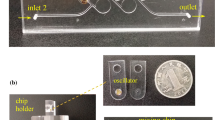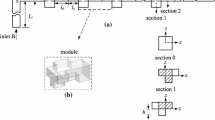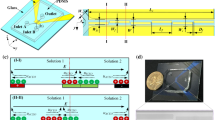Abstract
In this study, we investigate the mixing performance of a diverging microchannel driven by periodic electroosmotics. Applying two square-wave electric fields to the two inlets, the influences of the half-angle of the diverging section and the phase difference of the two actuating voltages are explored using different voltage configurations and superimposed pressure heads. Based on the analysis and flow visualization results, we find that two mixing mechanisms are present in the diverging micromixer driven by periodic electroosmotics: flow instability and fluid lamination. Furthermore, both the alternation of electric field and conductivity gradient present in the fluid may contribute to the onset of flow instability. On the other hand, mixing is enhanced by fluid lamination when the actuating voltages are not in-phase. For ϕ ≠ 0, fluid tends to flow first from one inlet directly into the other before moving to the opposite side of the diverging section in the following cycle to form fluid striations. As the phase difference increases, mixing is improved due to a longer active duration of this mechanism. We find that the mixing performance always peaks at a phase difference of 0.75π, and a diverging micromixer with a half-angle larger than 35° is preferred. Comparing to the unipolar actuation, bipolar actuation strengthens fluid lamellae and hence leads to higher mixing efficiency. Increasing the superimposed pressure head, on the other hand, weakens molecular diffusion and deteriorates mixing performance drastically.







Similar content being viewed by others
Abbreviations
- C :
-
Normalized concentration
- \( \overline{C} \) :
-
Time-averaged normalized concentration
- d :
-
Channel depth
- D:
-
Diffusivity
- E :
-
Electrical field
- f :
-
Excitation frequency
- h DC :
-
Steady pressure head
- i :
-
Time index
- j :
-
Spatial index
- \( \overline{ME} \) :
-
Time-averaged mixing efficiency
- M:
-
Total number of pixels in the evaluation area
- N:
-
Frame counts of image sequence in five cycles
- Reδ :
-
Stokes-Reynolds number
- T:
-
Total period of square wave
- t :
-
Time
- Ue :
-
Electroosmotic velocity
- w:
-
Channel width
- δ:
-
Diffusion length across which conductivity varies
- δs :
-
Stokes’ penetration depth
- ε:
-
Permitivity
- ϕ:
-
Phase difference
- μ:
-
Dynamic viscosity
- θ:
-
Half-angle of the diverging section
- ρ:
-
Density
- σ:
-
Conductivity
- ζ:
-
Zeta potential
- A:
-
Fluid A
- B:
-
Fluid B
- eff:
-
Effective
- ideal:
-
Ideal
- x :
-
x coordinate, aligned along the centerline of the diverging section
- y :
-
y coordinate, aligned along the centerline of the two inlet channels
- +/−:
-
Cation/anion
References
Chang C–C, Yang R-J (2007) Electrokinetic mixing in microfluidic systems. Microfluid Nanofluid 3(5):501–525. doi:10.1007/s10404-007-0178-z
Chen C-H, Lin H, Lele SK, Santiago JG (2005) Convective and absolute electrokinetic instability with conductivity gradients. J Fluid Mech 524:263–303. doi:10.1017/S0022112004002381
Coleman JT, Sinton D (2005) A sequential injection microfluidic mixing strategy. Microfluid Nanofluid 1(4):319–327. doi:10.1007/s10404-005-0034-y
Coleman JT, McKechnie J, Sinton D (2006) High-efficiency electrokinetic micromixing through symmetric sequential injection and expansion. Lab Chip 6(8):1033–1039
El Moctar AO, Aubry N, Batton J (2003) Electro-hydrodynamic micro-fluidic mixer. Lab Chip 3(4):273–280. doi:10.1039/b306868b
Glasgow I, Aubry N (2003) Enhancement of microfluidic mixing using time pulsing. Lab Chip 3(2):114–120
Hamadiche M, Scott J, Jeandel D (1994) Temporal stability of Jeffery–Hamel flow. J Fluid Mech 268:71–88
Hessel V, Löwe H, Schönfeld F (2005) Micromixers: a review on passive and active mixing principles. Chem Eng Sci 60(8–9):2479–2501. doi:10.1016/j.ces.2004.11.033
Leong J-C, Tsai C-H, Chang C-L, Lin C-F, Fu L-M (2007) Rapid microfluidic mixers utilizing dispersion effect and interactively time-pulsed injection. Jpn J Appl Phys 46(8A):5345–5352
Li F, Ozen O, Aubry N, Papageorgiou DT, Petropoulos PG (2007) Linear stability of a two-fluid interface for electrohydrodynamic mixing in a channel. J Fluid Mech 583:347–377. doi:10.1017/S0022112007006222
Lin C-H, Fu L-M, Chien Y-S (2004a) Microfluidic T-form mixer utilizing switching electroosmotic flow. Anal Chem 76(18):5265–5272
Lin H, Storey BD, Oddy MH, Chen CH, Santiago JG (2004b) Instability of electrokinetic microchannel flows with conductivity gradients. Phys Fluids 16(6):1922–1935. doi:10.1063/1.1710898
MacInnes JM (2002) Computation of reacting electrokinetic flow in microchannel geometries. Chem Eng Sci 57(21):4539–4558
Nguyen N-T (2008) Micromixers. William Andrew, NY
Nguyen N-T, Wu ZG (2005) Micromixers: a review. J Micromech Microeng 15(2):R1–R16. doi:10.1088/0960-1317/15/2/r01
Oddy MH, Santiago JG, Mikkelsen JC (2001) Electrokinetic instability micromixing. Anal Chem 73(24):5822–5832. doi:10.1021/ac0155411
Probstein RF (2003) Physicochemical hydrodynamics: an introduction (2nd edn), John Wiley, Hoboken, NJ
Sahu KC, Govindarajan R (2005) Stability of flow through a slowly diverging pipe. J Fluid Mech 531:325–334. doi:10.1017/s002211200500399x
Sun C-l, Sie J-Y (2010) Active mixing in diverging microchannels. Microfluid Nanofluid 8(4):485–495
Tang Z, Hong S, Djukic D, Modi V, West AC, Yardley J, Osgood RM (2002) Electrokinetic flow control for composition modulation in a microchannel. J Micromech Microeng 12(6):870–877
von Kerczek C, Davis SH (1974) Linear stability theory of oscillatory Stokes layers. J Fluid Mech 62(4):753–773
Acknowledgments
This work is supported by the National Science Council of Taiwan under grant number NSC 96-2221-E-011-100-MY3.
Author information
Authors and Affiliations
Corresponding author
Rights and permissions
About this article
Cite this article
Sun, Cl., Shie, SS. Optimization of a diverging micromixer driven by periodic electroosmotics. Microsyst Technol 18, 1237–1245 (2012). https://doi.org/10.1007/s00542-012-1475-3
Received:
Accepted:
Published:
Issue Date:
DOI: https://doi.org/10.1007/s00542-012-1475-3




